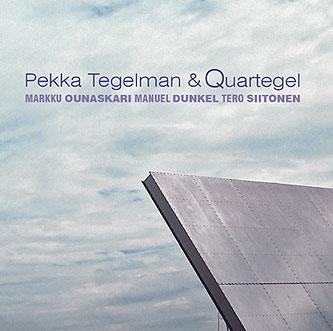 Back
in the late 1970’s, Pekka Tegelman was the guitarist in
the Finnish band Finnforest, who released several critically acclaimed
instrumental jazz-rock fusion albums on the now defunct Love Records
label. The glory years of Finland's Love Records label may be a distant
memory among Finnish rock and fusion enthusiasts yet, coming back
on the scene, Pekka Tegelman released his long awaited return to the
jazz-rock world in 2010 with the CD called Bound, recorded
with the group Kulumo. Flashing forward to 2017, after several vocal
projects, the renowned guitarist is back on track again with Pekka
Tegelman & Quartegel. The nine track CD features
Pekka on electric / acoustic guitars and keyboards with the aid of
Markku Ounaskari (drums), Manuel Dunkel (sax) and Tero
Siitonen (double bass). Mixing and mastering at Nevermind Ranch
in California by Pekka’s brother and former Finnforest drummer
Jussi Tegelman enhances the album's sound as does additional
percussion by Pete Korpela. Compared to the structured, neoclassical
rock music of the late, great Pekka Pohjola, for example, the music
of Pekka Tegelman is much more jazz-centric, with a keen emphasis
on creative melody and improvisation. Speaking about his fondness
for the American jazz music from which he partly draws upon for his
inspiration, Pekka Tegelman tells mwe3.com, "As for the music,
John Coltrane was a big influence on me when I was a kid, so this
is kind of a humble nod to the direction of Coltrane’s best quartet
with Elvin Jones, McCoy Tyner and Jimmy Garrison. The material we
play is basically “songs”. Hopefully they have a vocal,
singable kind of nature." Dunkel’s sax work tends to
dominate the album which also features some excellent guitar work
by Pekka. Fans of Finnforest, especially their Demonights album
from 1979, will find much to like about the freewheeling, improvisational
jazzy fusion sound of Pekka Tegelman & Quartegel. www.digelius.com
Back
in the late 1970’s, Pekka Tegelman was the guitarist in
the Finnish band Finnforest, who released several critically acclaimed
instrumental jazz-rock fusion albums on the now defunct Love Records
label. The glory years of Finland's Love Records label may be a distant
memory among Finnish rock and fusion enthusiasts yet, coming back
on the scene, Pekka Tegelman released his long awaited return to the
jazz-rock world in 2010 with the CD called Bound, recorded
with the group Kulumo. Flashing forward to 2017, after several vocal
projects, the renowned guitarist is back on track again with Pekka
Tegelman & Quartegel. The nine track CD features
Pekka on electric / acoustic guitars and keyboards with the aid of
Markku Ounaskari (drums), Manuel Dunkel (sax) and Tero
Siitonen (double bass). Mixing and mastering at Nevermind Ranch
in California by Pekka’s brother and former Finnforest drummer
Jussi Tegelman enhances the album's sound as does additional
percussion by Pete Korpela. Compared to the structured, neoclassical
rock music of the late, great Pekka Pohjola, for example, the music
of Pekka Tegelman is much more jazz-centric, with a keen emphasis
on creative melody and improvisation. Speaking about his fondness
for the American jazz music from which he partly draws upon for his
inspiration, Pekka Tegelman tells mwe3.com, "As for the music,
John Coltrane was a big influence on me when I was a kid, so this
is kind of a humble nod to the direction of Coltrane’s best quartet
with Elvin Jones, McCoy Tyner and Jimmy Garrison. The material we
play is basically “songs”. Hopefully they have a vocal,
singable kind of nature." Dunkel’s sax work tends to
dominate the album which also features some excellent guitar work
by Pekka. Fans of Finnforest, especially their Demonights album
from 1979, will find much to like about the freewheeling, improvisational
jazzy fusion sound of Pekka Tegelman & Quartegel. www.digelius.com
mwe3.com
presents an interview with
PEKKA TEGELMAN
 mwe3:
What was the main impetus behind the Pekka Tegelman & Quartegel
album and how did you decide on the title of the album? Is the group
name a kind of play on words, using your name to merge into the quartet?
Why did it take so long to get jazzy, fusion instrumental album this
amazing from you?
mwe3:
What was the main impetus behind the Pekka Tegelman & Quartegel
album and how did you decide on the title of the album? Is the group
name a kind of play on words, using your name to merge into the quartet?
Why did it take so long to get jazzy, fusion instrumental album this
amazing from you?
Pekka Tegelman: Well, there is actually a little wordplay.
I just wanted to avoid this “Xx and his Quartet”- tradition
Also, I like the word “tegel”, which means “brick”
in Finnish—as my forefathers may have been bricklayers, and my
father is an architect. So I wanted to have something constructive
on the title, yes, and merging it with “quartet”.
I had just finished my second vocal album Aurinko On Meidänkin
(“The sun is ours, also”) and I thought it would
be cool to release an instrumental album right after vocal, the same
year, though it’s tough that didn’t happen due to some technical
problems. The vocal CD came out 2016 and instrumental one Quartegel
in 2017, both consisting of my own material and performance. I don’t
know if anybody has done that…
mwe3: How did the Quartegel group come together? Have you known
these players for a while and did you choose the sax sound to give
the album a more jazzy sound, say compared to the rock-based fusion
of the early Finnforest albums? And how would you compare the sound
and scope of the Quartegel album with your other recent titles including
your recent vocal pop album and the Bound album by your band
Kulumo from 2010?
 Pekka Tegelman:
I had some difficulties in keeping the “Kulumo” group,
together and going, so I decided to do totally another project
and same time to fulfill my longtime wish to play with Markku Ounaskari,
again. Markku was in my “dreamband” HBA in the 1990’s
– with Pekka Pohjola, Jarmo Savolainen, Rasmus Korström,
Earl Boncamper and Ounaskari. That group made one recording for YLE
(Finnish Broadcasting Company) and some gigs, including a tour for
the Finnish Jazz Union. When Pohjola was, and if he was, in condition
to play and use his abilities, nobody could play as good as him, even
how good a bassist that guy might have been. He did not only play,
he at the same time composed counter-lines, he would hit an open string,
if the chord allowed, and then play something on the top of it that
suited perfectly to the melody that was been played. Quite
sadly, from that unit, all the first three guys have passed away,
so we can meet them only in our memories. May they rest in peace.
Pekka Tegelman:
I had some difficulties in keeping the “Kulumo” group,
together and going, so I decided to do totally another project
and same time to fulfill my longtime wish to play with Markku Ounaskari,
again. Markku was in my “dreamband” HBA in the 1990’s
– with Pekka Pohjola, Jarmo Savolainen, Rasmus Korström,
Earl Boncamper and Ounaskari. That group made one recording for YLE
(Finnish Broadcasting Company) and some gigs, including a tour for
the Finnish Jazz Union. When Pohjola was, and if he was, in condition
to play and use his abilities, nobody could play as good as him, even
how good a bassist that guy might have been. He did not only play,
he at the same time composed counter-lines, he would hit an open string,
if the chord allowed, and then play something on the top of it that
suited perfectly to the melody that was been played. Quite
sadly, from that unit, all the first three guys have passed away,
so we can meet them only in our memories. May they rest in peace.
But, saxophonist Manuel Dunkel has been strongly on the Finnish scene
since the 90’s and I’ve wanted to play with him long time,
and this was the opportunity! A rather moving detail, is that he plays
with a old Selmer tenor saxophone that was once owned by Rasmus. Tero
Siitonen came quite naturally from Kulumo, as he is the trusted one.
As for the music, John Coltrane was a big influence on me when I was
a kid, so this is kind of a humble nod to the direction of Coltrane’s
best quartet with Elvin Jones, McCoy Tyner and Jimmy Garrison. When
I was young, the most wonderful stuff I knew was the John Coltrane
Quartet playing "My Favorite Things", which was originally
a bona fide Broadway tune! And this was before me and Jussi heard
The Beatles. The material we play is basically “songs”…
Hopefully they have a vocal, singable kind of nature.
mwe3: I saw that Svart are reissuing the first two Finnforest
albums on vinyl, which is strange. Are the Laser’s Edge CD reissues
of the first two Finnforest albums still in print? How do you look
back to your early works in the 1970s with Finnforest? Do the Finnish
kids of today have some respect for the original progressive Finnish
fusion music? Is Svart run by younger people?
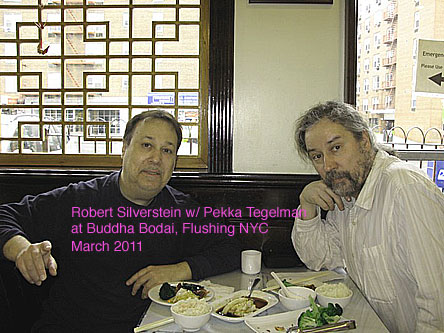 Pekka
Tegelman: I don’t know about Lasers Edge’s business
as they have been a somewhat hard act to make contact with even if
you are an artist that they have released material from. To put it
mildly, they did a great job releasing those albums, but that was
about it. I think there is some demand and interest for 1970’s
stuff in the younger generations, but it could be quite marginal.
I think Svart is run by younger people, but with myself, that is kind
of a relative notion.
Pekka
Tegelman: I don’t know about Lasers Edge’s business
as they have been a somewhat hard act to make contact with even if
you are an artist that they have released material from. To put it
mildly, they did a great job releasing those albums, but that was
about it. I think there is some demand and interest for 1970’s
stuff in the younger generations, but it could be quite marginal.
I think Svart is run by younger people, but with myself, that is kind
of a relative notion.
mwe3: How did you work on finishing the Quartegel album with
your brother Jussi Tegelman at his Nevermind Ranch recording studios
and what did Jussi bring to the album? How long has Jussi been living
in California and where does he live out there? Did you kind of “treat”
the Quartegel album with Jussi, adding in overdubs, etc? Also I saw
in the Quartegel album credits Jussi added in drums on the track “Time
To Time” and the drumming on that track is excellent by the way.
Do you miss your brother no longer living in Finland? I guess you
only see him time to time these days? Are your parents still alive,
other brothers or sisters in Finland?
Pekka Tegelman: We laid the basic tracks in Helsinki, E Studio
, with Jyri Riikonen on controls, and I went to do overdubbing, editing
and mixing to Jussi's Nevermind Ranch in Green Valley, California
because I did that with Kulumo album, and it worked very well then.
Jussi has a terrific skills and experience as a sound man and with
engineering, and he is of course a great musician and a composer of
his own right, so everything went very smoothly.
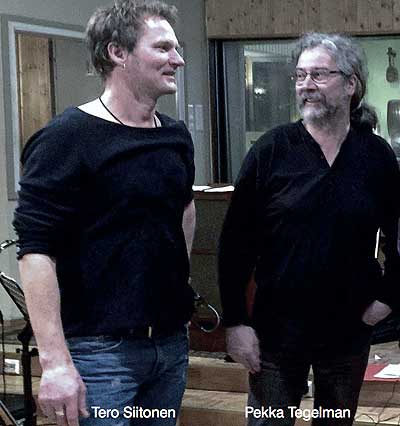 Nevermind
Ranch, some 50 minutes of freeway from downtown L.A., up to the mountains,
is a great place to work. The sun is shining and air is fresh and
it rains and snows considerably less than in Helsinki. Jussi has been
in Los Angeles since the beginning of 1990’s and he’s built
a strong career in the movie scene. I did certain overdubs and little
polishing, here and there, but you should not be able to hear when
and where. This practice may have come from the pop music way of working.
Nevertheless, it is the sonic outcome that matters.
Nevermind
Ranch, some 50 minutes of freeway from downtown L.A., up to the mountains,
is a great place to work. The sun is shining and air is fresh and
it rains and snows considerably less than in Helsinki. Jussi has been
in Los Angeles since the beginning of 1990’s and he’s built
a strong career in the movie scene. I did certain overdubs and little
polishing, here and there, but you should not be able to hear when
and where. This practice may have come from the pop music way of working.
Nevertheless, it is the sonic outcome that matters.
Yes we needed some extra punch to the song “Time To Time”,
so Jussi played second set of drums, and it came out fine. That was
actually one of the titles we played in 1990’s with Pekka Pohjola
and Jarmo Savolainen, so this bass riff was originally written for
electric bass. The problem with Pohjola, along with some other problems,
was that when he was at the top of his game, and there really was
nobody who could have taken over the bass duties after him, without
sounding lame, however good otherwise. So, that also drove me in the
direction of the double bass, which is actually great, because it
gives a band much greater and richer timbre.
mwe3: Would you say the music on the Quartegel album has a
certain “Finnishness” to it? Is that fair to say or has
the main era of Finnish fusion during, say the heyday of Wigwam, Pekka
Pohjola, Jukka Tolonen, … the mid 1970s, has passed? Are you
trying to revive some of that essential Finnish jazz-fusion sound
on the Quartegel album? The days of Wigwam, Pekka Pohjola and Finnforest
and the whole Love scene seems like a dream now. All those exciting
times etched in your memories.
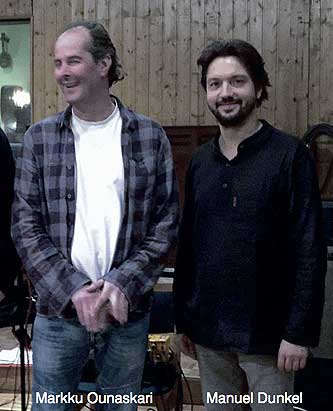 Pekka
Tegelman: All those guys you mentioned, Pohjola, Tolonen, also
Jukka Gustavson, they were a big influences on us younger guys, while
we were growing and learning. Then later, I did play with Pekka Pohjola
and the guitarist Jukka Tolonen, so a lot of mutual knowledge and
experience was met. Now that Pekka has been long gone and Jukka getting
his life together, and is actually playing bass, I think Gustavson
might be one of the only ones still active… Maybe. I myself am
only trying to get to play and hear my music, and aiming to get out
it, while I’m still able to do it. That is a great privilege.
Love Records was a remarkable happening in its own time and the one
main thing that I learned from those years was, and from Otto Donner
and Atte Blom, the two top guys, is that you can do anything if you
really you want it. And you should, because there is not anything
coming like, “I’ll do it later” thing. It’s too
late. Also, while Love Records has long been gone, the massive catalog
of the music it produced in the about 10 years of time still lives
on strongly and continues to affect people's lives in a very positive
way. That is the very meaning of Love!
Pekka
Tegelman: All those guys you mentioned, Pohjola, Tolonen, also
Jukka Gustavson, they were a big influences on us younger guys, while
we were growing and learning. Then later, I did play with Pekka Pohjola
and the guitarist Jukka Tolonen, so a lot of mutual knowledge and
experience was met. Now that Pekka has been long gone and Jukka getting
his life together, and is actually playing bass, I think Gustavson
might be one of the only ones still active… Maybe. I myself am
only trying to get to play and hear my music, and aiming to get out
it, while I’m still able to do it. That is a great privilege.
Love Records was a remarkable happening in its own time and the one
main thing that I learned from those years was, and from Otto Donner
and Atte Blom, the two top guys, is that you can do anything if you
really you want it. And you should, because there is not anything
coming like, “I’ll do it later” thing. It’s too
late. Also, while Love Records has long been gone, the massive catalog
of the music it produced in the about 10 years of time still lives
on strongly and continues to affect people's lives in a very positive
way. That is the very meaning of Love!
mwe3: Tell us about your guitars that you played on the Quartegel
album and did you overdub acoustics to make the sound richer and how
about keyboards? And how about keyboards you use on the album?
Pekka Tegelman: I basically played Fender Stratocaster for
the electric parts and Lottonen acoustic guitar. Some things on acoustic
steel string were overdubbed, to get a richer tone. I played the piano
parts with E-Studio’s grand piano on the first two tracks, “All
Folks” and “Do Ra Mi”, but did some overdubbing with
Jussi’s grand piano, that he had just bought a few years ago
from Frank Strazzeri (1930-2014), who used to play with Billie Holiday
and Roy Eldridge, Chet Baker among others, and played with Elvis Presley
on the “Aloha From Hawaii” concert! So there are echoes
of history somewhere, if you want to hear it…
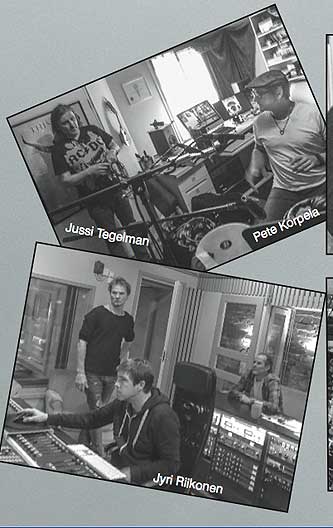 At
Nevermind Ranch I also used Jussi’s Fender Telecaster with Mad
Professor amp and Galen Walker lent me his great Gibson Hummingbird
for some acoustic parts. GHS –strings 10-52 is my basic set.
Studio keyboards and samples were used when necessary.
At
Nevermind Ranch I also used Jussi’s Fender Telecaster with Mad
Professor amp and Galen Walker lent me his great Gibson Hummingbird
for some acoustic parts. GHS –strings 10-52 is my basic set.
Studio keyboards and samples were used when necessary.
mwe3: You’re also an excellent photographer, so did you
take all the photos in the CD and booklet? Looks like a monolith on
the CD front cover art. Also who did the bird painting on the inside
cover and the castle pic in the centerfold and the airplane signifies
what? And how about the funfair wheel on the inside of the cover?
Have your photographs been featured in some shows or exhibitions?
Pekka Tegelman: Well, I did all the photography, and, as a
matter of fact I have a wide collection of images that I work on,
when I have the urge. I tend to “document” the places I
manage to travel to. The castle is from Yorkshire area in England,
the funfair from Manchester, England, and the scarecrow from Veikkola,
where I now live, some 30 kilometers from Helsinki. The front cover
monoliths are from Boston, the harbor area, if my memory serves me
right. And the tree and the aeroplane pic was taken, when I visited
you in the Queens area of NYC few years ago, when I was walking back
to subway! So, you were part of the process! I don’t consider
myself as a “photographer”, as I haven’t studied it,
but I like to capture the moment.
mwe3: What’s new in Finland these days? Seems like the
world went through a big upheaval last year, and the arrival of Trump,
yet people are still fighting for their rights. Do you think the Finnish
government will ever legalize Cannabis as a logical alternative to
alcohol and even nicotine. Where do you see the world going in the
next year or two?
Pekka Tegelman: Well, we certainly did not see Mr. Trump coming,
and so didn’t you Americans! As we see, “democracy”
is a difficult thing. We see that with the former Eastern Europe.
Finland is geographically so at the bottom of the bag, so we have
been saved from the most major refugee problems, though in our own
 scale
we sure have to take part in trying to solve this huge global question.
Surely, we won’t be trying to build a wall between us and Russia,
our borderline is some 1300 km long, so it’s better to still
try diplomacy… about substances, I’ll think that historically,
Finland will follow what Sweden does first, haha!
scale
we sure have to take part in trying to solve this huge global question.
Surely, we won’t be trying to build a wall between us and Russia,
our borderline is some 1300 km long, so it’s better to still
try diplomacy… about substances, I’ll think that historically,
Finland will follow what Sweden does first, haha!
mwe3: What other activities keeps you busy in Finland these
days? Are you doing production work with other artists and what do
you think of the Finnish music scene in 2017? Seems like there’s
some great Finnish artists currently but not the wildly creative kind
of scene like there was 40 years ago. What other plans do you have
for the remainder of 2017 and into 2018?
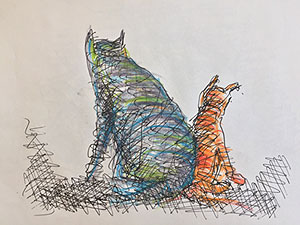 Pekka
Tegelman: Well, as I write these words, I’m at Hydra island
in Greece, and later I’ll be paying a visit to the “Roloi”
café, a place where Leonard Cohen used to sit and enjoy his
spare moments, while living and crafting his poetry in the 1960s.
So this is a short term activity for me, right now! But seriously,
and still linked to the previous; To write, you don’t need much,
so for me that is going to continue. There are many projects that
I work on this moment, so I won’t be retiring, though I turned
just 60.
Pekka
Tegelman: Well, as I write these words, I’m at Hydra island
in Greece, and later I’ll be paying a visit to the “Roloi”
café, a place where Leonard Cohen used to sit and enjoy his
spare moments, while living and crafting his poetry in the 1960s.
So this is a short term activity for me, right now! But seriously,
and still linked to the previous; To write, you don’t need much,
so for me that is going to continue. There are many projects that
I work on this moment, so I won’t be retiring, though I turned
just 60.
I think I have material for few more Quartegel albums, so that is
on the menu. I just finished a 3 song single with a great new singer
Piia Tuovinen. She sang three of my songs, which I produced and played
on, and it should ready for airplay next month. A “forever”
project, from 1998, comwith actor-singer Martti “Manu” Suosalo
keeps me busy with a Jaques Brel-project, along with my trio and now
also with the Tapiola Big Band, doing concerts around Finland. During
last 5 years I’ve also made drawings of my cats Dessa and Emppu,
both British-cats, so maybe it is time to put them on display!
Thanks to Pekka Tegelman and to Jaku Havukainen
for use of his photographs.



